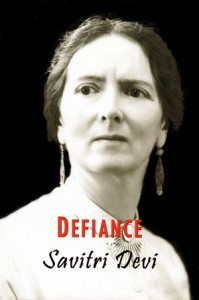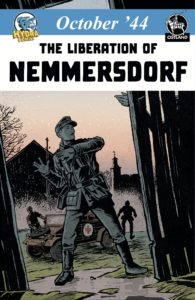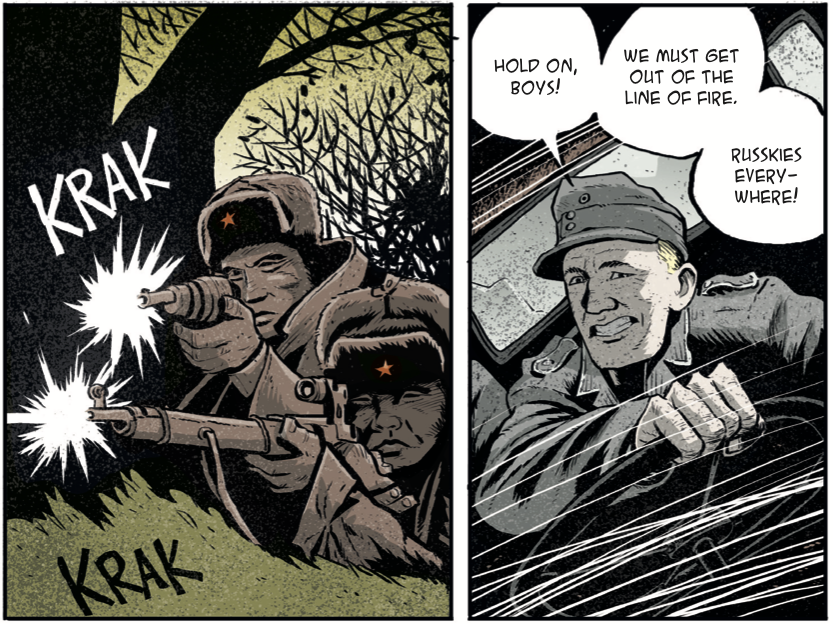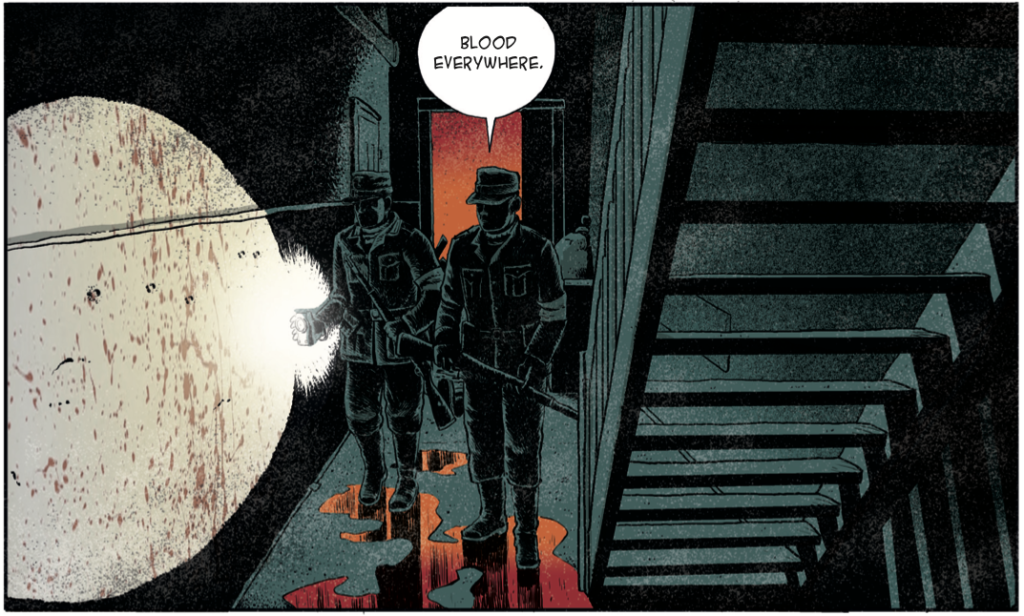October ’44 — The Liberation of Nemmersdorf:
A Graphic Novel
Clarissa Schnabel
October ’44 — The Liberation of Nemmersdorf
Written by Markus Pruss
Illustrated by Paul Freytag
Translated by Nils Wegner
Dresden: Hydra Comics, 2023
In February 2023, German comics publisher Hydra Comics released their first historical piece: Oktober ’44 — Die Befreiung von Nemmersdorf (October ’44 — The Liberation of Nemmersdorf). Hydra describes itself as a publisher for “non-conformist” art — meaning, of course, a publisher for the dissident Right.
Although most of the reactions were supportive, there were those critics who condemned turning the events at Nemmersdorf into “light entertainment” that kids could browse through while eating hamburgers. Of course, those very same critics also pointed out in (self-)righteous indignation that they had never read a graphic novel in all their lives and would never do so. The reason for this is probably a still-widespread ignorance of comic book culture in Germany. In contrast, the bande dessinée has long been used in France and Belgium to tell “grown-up” stories (I hesitate to use the word “adult,” but yes, those are out there, too), as well as to depict the lives of historical figures — and to educate. A popular series aimed at older children for that purpose, for example, is Les enfants de la Résistance. The most prominent example in the English language is, of course, Art Spiegelman’s Maus.
The Liberation of Nemmersdorf has now been released in an English translation, so I thought it would be a good occasion to talk about what the graphic novel is and what it is not. First of all, it is neither light entertainment nor a book for children, hamburger-eating or otherwise. Hydra put the recommended age at a minimum of 16 years; in other words, reader discretion is advised. Although the presentation is not overly graphic (haha), it can’t skip the gruesome facts. Nemmersdorf is also, contrary to what the usual suspects might think, anything but Right-wing propaganda.

You can buy Savitri Devi’s Defiance here.
On October 20, 1944, Red Army troops captured the German village of Nemmersdorf in East Prussia, about 40 kilometers from the German-Soviet border. A German counterattack liberated Nemmersdorf two days later, only to find 110 persons — 26 inhabitants, 82 refugees, and two French prisoners of war — brutally murdered. Several of the women had been raped. The findings that were published in the Völkischer Beobachter on November 2, 1944 have of course been denied and disputed ever since, a common accusation being that the photos, if not the events themselves, had been staged by the German Ministry of Propaganda.
There is, of course, a kernel of truth to it. Yes, the story made for excellent propaganda insofar as it warned both German soldiers and civilians of what would happen if they ever let Soviet soldiers set foot on German soil. It was meant to reinforce the people’s will to fight. Propaganda has been used — and continues to be used — in any war and at any front for that very purpose. This doesn’t mean that it’s all lies. As the later conduct of the Red Army showed, it is sadly only too likely that the events of Nemmersdorf happened exactly as reported.
Let me quote from the Hydra blog (my translation):
The recently opened Dokumentationszentrum Flucht, Vertreibung, Versöhnung [Documentation Center Flight, Expulsion, Reconciliation] in Berlin is an example of the taboo surrounding and the suppression of the events that took place in Nemmersdorf in October 1944. In the exhibition’s conceptual design, the center contextualizes the massacre of Nemmersdorf historically in a few sentences, but in the completed, permanent exhibition on the upper floor, “Nemmersdorf” is not mentioned in even one syllable on the text panels! This is all the more surprising given that in most publications about East Prussia in 1944/1945, Nemmersdorf is considered to be the signal for the flight and expulsion of the Germans. Our unconventional comic October ’44 — The Liberation of Nemmersdorf would like to close these historical gaps in the German culture of remembrance by depicting the suppressed experiences of the Second World War from the point of view of our German grandparents and great-grandparents . . .
It tells the story of young East Prussian sons and war-wounded veterans who are sent by the military leadership on a suicide mission against a superior Soviet force, then experience the fear and horror of war, and are finally able to liberate the village after all. The author of the comic, Markus Pruss, is a historian who specializes in the flight and expulsion of Germans from East-Central Europe. Contrary to Soviet denials, his recent discoveries in the archives of the German Foreign Office and the Freiburg Military Archives make it exceedingly likely that there were indeed a large number of assaults by Soviet troops on the civilian population in Nemmersdorf as well.
Markus Pruss added an extensive editorial section to this comic; it is almost as long as the graphic novel itself. Pruss presents his findings in it, along with his sources. One of the more obscure facts about the liberation of Nemmersdorf, for example, is that, as Pruss writes, it was not as heroic as some eyewitness accounts painted it. Because of a lack of coordination during the advance, German troops may have been subjected to so-called friendly fire. And speaking of the obscure, unless you are quite versed in this topic, you may have heard of Nemmersdorf, but not of the people involved. I certainly hadn’t. The graphic novel seeks to redress this oversight. The story is told through the eyes of ordinary people — those unknown individuals who were caught up in the events at Nemmersdorf.
Paul Freytag’s illustrations are in a straightforward, clear style, which is fitting for a comic book that could serve as an educational resource — although I won’t get my hopes up on that ever happening.
If there is one thing that I would criticize about Nemmersdorf, it is, ironically enough, its pedagogical mission. (A very German attitude, I might add!) Now, considering everything stated above, I understand why this particular approach was chosen; and as a somewhat source-obsessed researcher myself, I both congratulate and sympathize with the author. But — notwithstanding the topic itself — this approach feels a bit heavy. Les enfants de la Résistance, for example, also features editorial sections, but at a ratio of 48 pages of story to seven pages of background information.
Still, this is a minor complaint. All in all, Nemmersdorf is a successful start to Hydra’s new Ostland label, and I look forward to future installments.
* * *
Counter-Currents has extended special privileges to those who donate at least $10/month or $120/year.
- Donors will have immediate access to all Counter-Currents posts. Everyone else will find that one post a day, five posts a week will be behind a “paywall” and will be available to the general public after 30 days. Naturally, we do not grant permission to other websites to repost paywall content before 30 days have passed.
- Paywall member comments will appear immediately instead of waiting in a moderation queue. (People who abuse this privilege will lose it.)
- Paywall members have the option of editing their comments.
- Paywall members get an Badge badge on their comments.
- Paywall members can “like” comments.
- Paywall members can “commission” a yearly article from Counter-Currents. Just send a question that you’d like to have discussed to [email protected]. (Obviously, the topics must be suitable to Counter-Currents and its broader project, as well as the interests and expertise of our writers.)
To get full access to all content behind the paywall, please visit our redesigned Paywall page.
October%20and%238217%3B44%20and%238212%3B%20The%20Liberation%20of%20Nemmersdorf%3A%0AA%20Graphic%20Novel%0A
Share
Enjoyed this article?
Be the first to leave a tip in the jar!
Related
-
The Significant and Decisive Influence that Leads to Wars
-
Get to Know Your Friendly Neighborhood Habsburg
-
Nowej Prawicy przeciw Starej Prawicy: Przedmowa
-
Stalin’s Affirmative Action Policy
-
Sperging the Second World War: A Response to Travis LeBlanc
-
Doxed: The Political Lynching of a Southern Cop
-
James M. McPherson’s Battle Cry of Freedom, Part 2
-
The Holocaust Card Can No Longer Be Played



9 comments
I just can’t read it – I know what happened. Still I thank you for bringing it to our attention. I deeply regret that the stupidest government in the world, which unfortunately runs my country, chose to cover it up. Much more so I regret that they backed Communism at the time.
To be fair, it is and was mainly Russia that refuses to acknowledge what happened – in Nemmersdorf and elsewhere. And as for the stupidest government in the world, the one that runs my country could give yours a run for their money…
But I know what you mean. Back when I did the research for my book on Marta Hillers (author of A Woman in Berlin), I was an emotional wreck for months on end. I think I’m still traumatized just from reading about it.
Thank you for your kind words.
Great article. I’m not a big fan of graphic novels but maybe I could be converted.
🙂
I don’t know if starting out with something like Nemmersdorf is helpful in converting you – but by all means, try it! 😉
Are you in the mood for a nerve-wracking non-fiction book? Then pick up Gerhard Wisnewski’s The Titanic Assassination. Just in time for the 111th anniversary of the sinking of the Titanic (April 15, 1912), the renowned investigative author is reissuing this book that revolutionized Titanic research – largely to the exclusion of the public, of course. Bravely ignored by the mainstream, it was soon out of print.
By popular demand, Kopp Verlag is lifting this breathtaking non-fiction treasure and reissuing it! After all, the sinking of the Titanic is red-hot: as a symbol of a doomed society, whose members are nevertheless sailing to their doom with their eyes open. It would be interesting to find out whether this was really just a chain of unfortunate circumstances – or whether it was intentional.
What was and is there to discover after such a long time? Answer: everything. Because whether it’s Pearl Harbor, the Kennedy assassination or September 11, 2001: the truth is still being kept from us today. Why should it be any different with the Titanic? Exactly. And indeed: evidence was suppressed, witnesses were not heard or disappeared. The most important findings were ignored, explained away and hushed up.
For example:
– the captain of the Titanic survived the sinking in 1912,
– the Titanic was converted into a deadly trap for the rich passengers before it sailed,
– the Titanic shipping company went bankrupt before the maiden voyage,
– the giant steamer was deliberately and consciously steered into the ice,
– the crew and passengers were made drunk during a debauched binge, and much more.
The sinking of the Titanic was not an accident but an assassination.As always, Gerhard Wisnewski, the perennial guest of the bestseller lists, takes his sharp analytical scalpel to hand and dissects the Titanic sinking by every trick in the book.The result is unprecedented: The Titanic did not sink after colliding with an iceberg, but because of sabotage.
https://www.youtube.com/watch?v=fhh4kb7U45I
The adventurer and investigative journalist Billy Six is known for his dangerous reports from various hot spots around the world. He was released from a Syrian prison only with the help of Russian Foreign Minister Lavrov. The latter also helped him when Billy Six was imprisoned in Venezuela in 2018 on charges of espionage.
Despite his experiences – or perhaps because of them – Billy Six has been drawn to Belarus and Ukraine for the past two years. There he recently produced his latest documentary film “Front City Kharkov”. And those who are now expecting a pro-Russian narrative will once again be surprised by a journalist who spares hardly any risk in order to always get his own picture.
https://www.youtube.com/watch?v=vlIn81KBp-c
1. Click on the Subtitles/Closed captions option.
2. Click the settings cog and choose Subtitles/CC.
3. Finally choose Auto-translate; picking English.
I visited Kaliningrad in 2008. The city was known as Königsberg from the date of its founding in the 13th century until 1945. My mother was born in Memel (now called Klaipeda), which is 85 miles away from Kaliningrad. Her family owned a summer home a few kilometers away from Konigsberg. I had been to Klaipeda a few years earlier.
I stayed at a nice hotel, very Germanic in style, run by some nice Russian women. I remember meeting a Lithuanian guy there who served in the Soviet army in the 1970s or 1980s. I was able to find the small village (maybe a couple hundred people) where my mother’s family home was on a Russian-German map, and I took a bus there. I had to walk the last mile on a dirt road to get to it.
I thought about visiting Nemmersdorf. It’s not too far from Kaliningrad, but ultimately I didn’t go. There is no reason to doubt the Nemmersdorf atrocity. There were many German witnesses to that and similar atrocities carried out by the Soviet army, including the gang raping of two million German women and murdering many afterwards. There were eyewitnesses to such events, such as the author, Ingrid Rimland, now deceased. My own mother was captured in Pilsen, Czechoslovakia, and was lucky to escape with her honor.
Every allied atrocity against the Germans is downplayed, lied about, or denied, and the weak German government willingly supports the lies. There is solid proof that at least 135,000 Germans were murdered at Dresden from the number one expert on the subject, British historian David Irving, and the German government pushes the lie that 25,000 people died. That same government allows leftist traitors to disrupt any memorial services held for the victims, and they have shouted “Bomber Harris, do it again”. Harris was a British Air Marshall. The atrocities committed against the Germans by the allies are downplayed by the millions, with the atrocities continuing after the war was over. My uncle was a POW in France for three years after the war, and he told my relatives of the brutal treatment he received.
On the other side, the allies, with a strong Jewish role, have told so many outrageous lies, but that doesn’t stop them from telling more. They made up discredited stories of soap made from human fat and lampshades made from human skin. In the early 1990s, a sign that had stood at Auschwitz for about 45 years that said four million people were murdered there was replaced by the authorities there with a sign that said 1.5 million people were killed. It will ultimately come out that perhaps less than 100,000 people died there, but not by gassing. From disease.
The allies have also told gross lies about Germans killing millions of Soviet civilians, when in fact, large numbers of Soviet civilians from Ukraine, Belarus, the Baltic countries, and Russia itself welcomed the Germans as liberators from the murderous USSR.
Below, I linked to Norwegian academic Johannes Due Enstad’s book on the German army in the USSR. Many Russians (in addition to Ukrainians, Byelorussians, Estonians, and Latvians) hoped that Hitler would free them and welcomed the German soldiers as liberators. There is also substantial film footage of the beleaguered Soviet citizens welcoming the Germans.
https://www.hf.uio.no/ilos/english/research/news-and-events/news/2018/many-russians-hoped-that-hitler-would-free-them-fr.html
Just as the four million figure from Auschwitz was just made up and the Soviet atrocity against Poles in 1941 was blamed on the Germans at Nuremberg and afterwards, it’s a lie that the Germans killed millions of civilians. Many terrorists (called “partisans”) were killed, and there were occasions when civilians were mistreated amid the horror thrown at the Germans, but there is as much evidence for the oft-quoted 25 million Soviet casualties as there was for the four million dead at Auschwitz.
Meanwhile, RFK Jr. prefers Jerusalem over Berlin.
https://www.youtube.com/watch?v=bp05yIhXtT4
The Russians lost about 14 million civs in the war of which most were not killed by direct violence but by starvation, exposure and by having them worked to death. I really resent this victim narrative about “oh no the germans didn’t murder anyone, in fact it was reverse and we are the real victims here” cause its weak and fake. A 110 bodies, no matter how brutally killed? Nice try, still here.
Having now taken a look at the comic itself graphic novel is a fitting description. Its just graphic. Its pornographic pulp. What is the point of having this? The war against ukraine is going on for over a year, the best documented war in history so far, and everyone can see how russian occupation looks like when they torture what they themselves call “little brother peoples”. What point is there to it creating this novel about something that is in the past so far everyone involved is dead and most of their children are dead by now. Also the work itself, dialouge wise, is really unimpressive. It has no substance beyond the shock value. There is just no sense to it. No sense at all.
Comments are closed.
If you have Paywall access,
simply login first to see your comment auto-approved.
Note on comments privacy & moderation
Your email is never published nor shared.
Comments are moderated. If you don't see your comment, please be patient. If approved, it will appear here soon. Do not post your comment a second time.
Paywall Access
Lost your password?Edit your comment